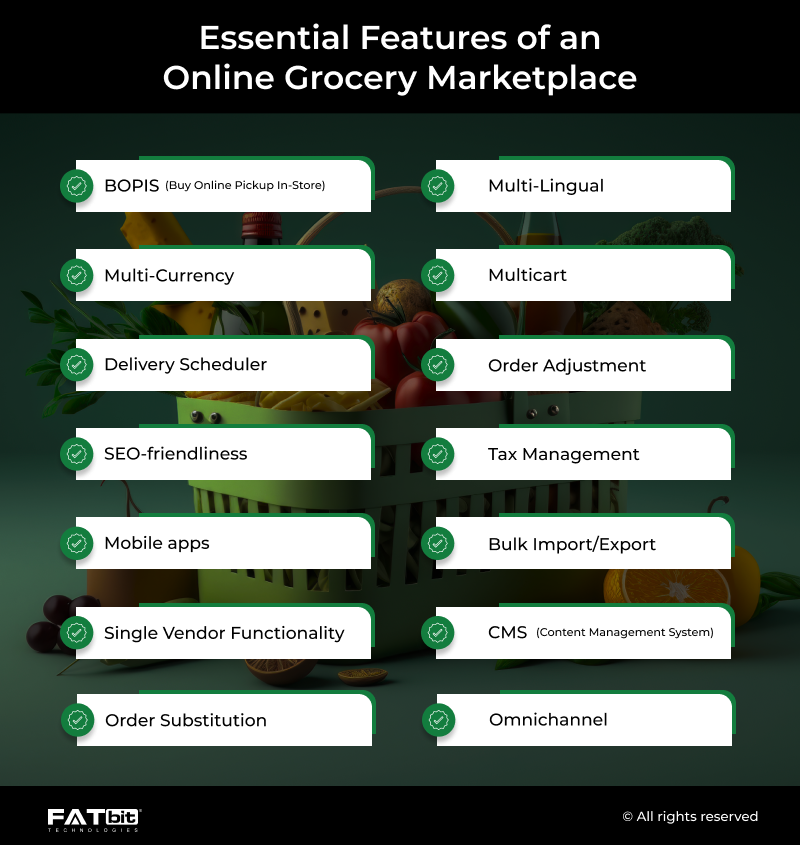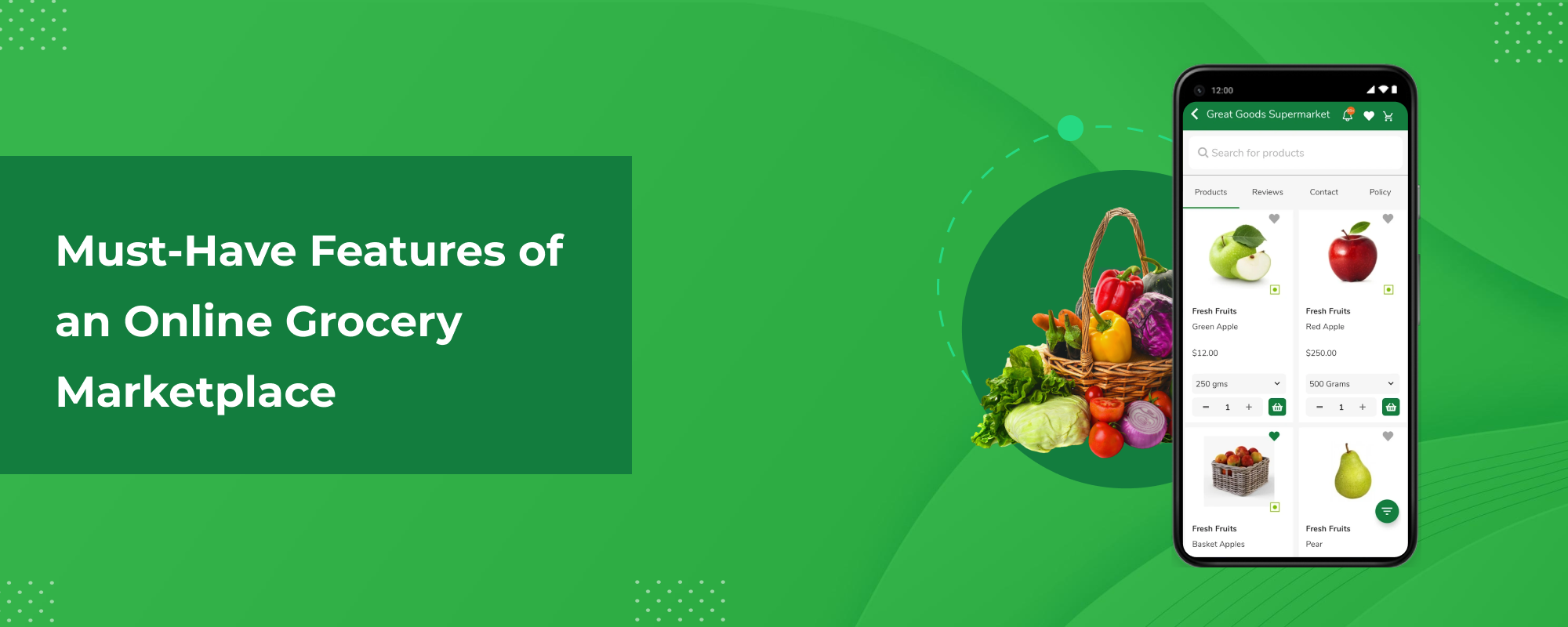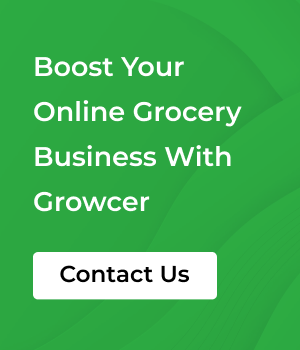Essential Features of an Online Grocery Marketplace
Buying groceries online is not a new norm. However, it becomes challenging for online grocery businesses to keep up with the changing modern customer demands.
So, having these below-mentioned essential features can be a great help. These contribute to the functioning of an online grocery marketplace while improving the user experience.

BOPIS (Buy Online Pickup In-Store): This feature is a great blend of both offline and online shopping. It allows customers to shop online and pick up their orders from a physical store while offering a convenient way to shop.
Multi-Lingual: The multi-lingual feature allows buyers to access and browse the platform and shop in their preferred language, catering to a diverse user base.
Multi-Currency: The multi-currency functionality enables users to view product prices and pay in their local currencies.
Multicart: This feature enables customers to conveniently add multiple products from different stores to a single cart and facilitates single checkout. It streamlines the shopping process, boosting the overall customer experience.
Delivery Scheduler: This feature empowers buyers to seamlessly schedule delivery while placing an order based on available time slots. Furthermore, it offers a convenient self-pickup option, allowing users to select a specific date and time. Customers can also set varied delivery schedules for orders from different stores. This functionality ensures that customers receive their groceries at their preferred times, significantly enhancing overall satisfaction.
Order Adjustment: It allows sellers to adjust the order if an item is out of stock by suggesting a similar item. Thus, eliminating the chances of full order cancellation and adjusting the unavailable items only.
SEO-friendliness: Optimizing the platform for search engines helps attract more organic traffic by improving visibility and search rankings. It includes targeting keywords, URL rewriting, optimizing meta tags, and managing sitemaps. Further helping reach a larger audience and increase sales.
Tax Management: The tax management feature in an online grocery marketplace allows admin(s) to set up, configure, and manage various taxes applicable to products sold by vendors. The admin(s) can define specific tax rates based on different regions or product categories, ensuring accurate tax calculation during the checkout process. It provides transparency and compliance with tax regulations, giving control over tax settings, reporting, and collection and facilitating smooth financial operations.
Mobile apps: While responsive websites exist, mobile apps are great for enhancing customer’s shopping experience in this digital era.
The grocery buyer app supports users throughout their entire purchasing journey, starting from registration and item selection to placing orders and making payments for groceries. On the other hand, the grocery delivery app helps delivery personnel by providing access to order details, assisting with route navigation, and ensuring the timely delivery of orders, enhancing the overall grocery delivery experience.
Bulk Import/Export: An import/export functionality facilitates the hassle-free and quick uploading or downloading of product information such as brands, categories, tags, seller catalogs, tax groups, users, seller inventories, and product options via .CSV file format.
Single Vendor Functionality: This feature enables admin(s) to switch from multivendor to single vendor platform. As a result, they can efficiently manage operations, ensuring continuity and flexibility in their business operations.
CMS (Content Management System): This feature allows admin(s) to centrally manage and organize various content forms such as product listings, images, descriptions, and promotional banners. Furthermore, admin(s) can manage content pages, navigation, video content, language labels, FAQs, blogs, homepage slides, and email templates.
Order Substitution: Order substitution functionality enables buyers to select between brands to find suitable alternatives to unavailable items before they place an order. This brings the grocery shopping experience to their fingertips while ensuring their satisfaction remains high.
Omnichannel: It enables customers to seamlessly shop across various channels (website, app, social media) while also providing them with the option to share their purchases on social platforms.
Launch Your Feature-Rich Online Grocery Marketplace
Operations and Management Features
Inventory/Product Catalog Management: This feature enables admin(s) and sellers to add, update, and organize product listings including setting up details like product names, descriptions, images, prices, quantities, and more. Admin(s) also manage inventory levels and handle product categorization for seamless browsing and ordering experience of customers.
User Management: Admins can manage the profiles of all marketplace users. They can add, delete, or view users, log in to user accounts, edit user profiles, and manage ratings and reviews.
Order Management: It enables management of the entire lifecycle of orders including listings, search, filtering, detailed order views, and seller suborders. All this facilitates better organization and tracking and handling of orders, enhancing overall customer satisfaction and streamlining the grocery marketplace’s operations.
Delivery Order Management: Delivery personnel can view order IDs along with details such as distance, location, and other particulars to help make informed decisions on whether to accept or decline delivery requests.
Shop Management: This allows sellers to manage shop details, set return addresses, pin the shop location on a map, and enable the activation or deactivation of the store to efficiently manage their online presence and operations aspects within the grocery marketplace.
Notifications Management: This feature includes strategic handling and delivery of updates, alerts, and reminders to the users via SMS, push notifications, and email. It ensures timely communication about order confirmations, promotions, and restocking, boosting customer engagement and improving user experience.
Payment Oriented Features
Multiple Payment Options: Multiple payment choices like Credit cards, Debit cards, Cash on delivery, Net banking, and Digital Wallets provide customers the convenience of choosing their preferred method and placing orders hassle-free.
Coupon Codes and Rewards: Customers get attracted to offers and rewards in return for purchases. Hence, incorporating loyalty reward programs and coupon codes boosts user engagement and encourages recurring orders.
Wallet Management: This feature enables sellers, buyers, and delivery staff to manage all their earnings and virtual credits efficiently. Also, they can monitor and manage money withdrawal requests.
Commission Management: The admin(s) can define the commission on products, further facilitating complete management of all transactions, deliveries, and seller wallet calculations.
Order Tracking: This feature enables buyers to track the progress of their purchased items from the point of purchase to delivery. It provides real-time updates and information like when the shipment will arrive, offering transparency and assurance regarding the status of their orders.
Advertisements: Vendors can leverage banner ads or PPC ads to showcase their range of offerings and boost their brand’s reach. In return, the marketplace earns revenue on each click.
Sitemap: The feature enables search engine crawlers to efficiently locate and index all web pages within the marketplace. Thus, improving search engine rankings for most of the content and increasing the marketplace’s overall online presence.
Blog Integration: This feature enables admin(s) to publish relevant and engaging content regularly. It boosts customer engagement, driving audience and establishing brand authority in the online grocery delivery market.
Pre-Integrated Third-Party APIs
The marketplace can be integrated with third-party APIs such as:
- MailChimp
- Google Maps
- AWeber
- Google Analytics
- Stripe
- PayPal
Trending Features As Per The Demand
Guest user checkout: The guest checkout option in an online grocery store lets customers buy without making an account. It’s convenient, speeds up purchases, and attracts new buyers, saving them from signing up.
Geo-location: Automates identifying user’s location to provide them with nearby grocery store options delivering to their location. Thus, enhancing convenience and tailored user experiences.
Progressive Web Apps (PWAs): PWAs of online grocery marketplace enable admin(s) to combine the best possible experiences of both web and mobile apps. The benefits offered by PWAs include better performance and cost-effectiveness.
Route navigation: The delivery staff can use GPS navigation to locate both the store and the customer’s address, enhancing delivery fulfillment.
Multiple revenue streams: Support for diverse revenue streams such as commissions, subscriptions, affiliate partnerships, advertisements, and listing fees are vital for consistent business growth.
Workflow of Different User Types in an Online Grocery Marketplace
Admins
- Get complete control over online grocery marketplace operations
- Manage user accounts, including registration, verification, and resolving account-related issues
- Manage adding, updating, and deleting of products, seller inventories, and payment methods
- Monitor and facilitate smooth ordering processes like accept/reject returns and initiate refunds
- Set commissions on products
- Track data to identify trends, make informed decisions, and generate reports
Buyers
- Use search filters to find specific groceries or browse categories
- Use auto-detected GEO location to identify nearby stores or manually adjust their location preferences
- Choose preferred shops, add desired items to their carts, and place orders, expecting timely deliveries
- Select a payment method to complete the transaction
- Review order details and track order status until received
Sellers
- Create and manage their storefronts
- Add/administer product catalogs, define delivery schedules, view wallets, and handle return and cancellation requests.
- Define the delivery zones, set zone-based delivery charges, and deliver time estimates tailored to each zone’s orders.
Delivery Staff
- Accept/reject order requests
- View order details, credits, earnings, and admin commission
- Define the radius within which they can deliver orders
- Pick orders and deliver efficiently to the customer’s doorsteps
How Growcer is the Ideal Choice to Boost Your Online Grocery Business?
After assessing the key aspects of an online grocery marketplace, the next step is selecting suitable software that comprises the aforementioned. Fortunately, Growcer software supports all the essential features to help your marketplace stand out.
The software and its features come with one-time costs which include the initial setup and configuration charges. Moreover, to ensure smooth business operations, Growcer comes with 12 months of free technical support. In a nutshell, equipped with vital features and functionalities, Growcer can efficiently elevate your online grocery business’s overall growth.
- Fully customizable and scalable
- 100% white-label with Lifetime Access
- Source Code Ownership
- Readymade mobile apps for buyers and delivery staff
Discover the Comprehensive Features of Growcer
Closing Remarks
The increasing popularity of online grocery shopping presents an immense opportunity for entrepreneurs to start an online grocery platform. However, boosting business growth and standing amidst competition requires the marketplace to be equipped with the exceptional features discussed above. Besides, you can leverage Growcer, a turnkey eCommerce software developed by FATbit Technologies. It encompasses all the vital features and functionalities to help you drive sales and deliver the utmost customer satisfaction essential for marketplace growth.


